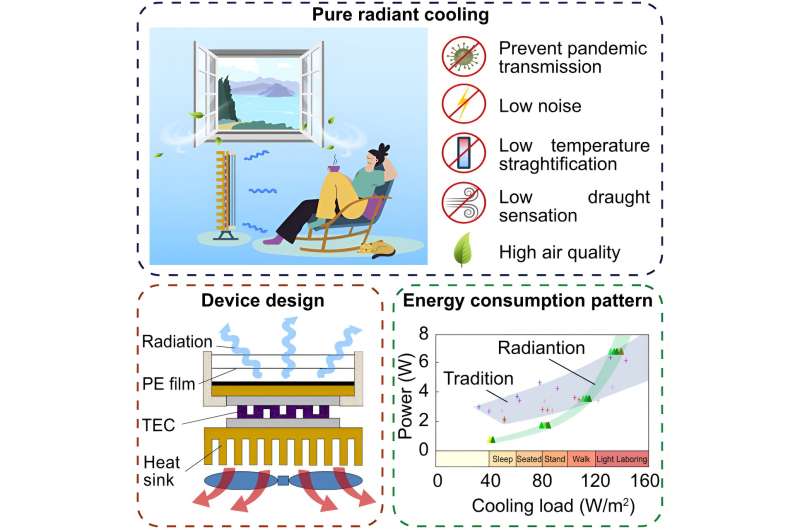September 4, 2024 report
This article has been reviewed according to Science X's editorial process and policies. Editors have highlighted the following attributes while ensuring the content's credibility:
fact-checked
peer-reviewed publication
trusted source
proofread
Radiant cooling device uses significantly less energy than traditional air conditioning

A team of sustainable energy engineers at The Hong Kong University of Science and Technology, working with a pair of colleagues from the GD MIDEA Air-Conditioning Equipment Co., LTD., in China, has developed a personalized cooling apparatus to replace traditional air-conditioning.
In their paper published on the open-access site, Cell Reports Physical Science, the group explains how the device works without conditioning the air.
Prior research has suggested that approximately 7% to 10% of global energy use goes toward cooling buildings and homes. Most such cooling is done using refrigerated air conditioning systems that work by blowing hot air over chilled coils—an approach the engineers on this new effort describe as very inefficient.
Blowing cold air around in enclosed spaces is unhealthy because it can help disperse airborne viruses such as those that cause the flu, colds and COVID-19. In this new study, the group developed a personal cooling device that they claim uses approximately half as much energy as a traditional air conditioner.
The new design by the researchers is based on radiative cooling, where a person or even a room is cooled directly rather than by moving air. Prior attempts to make such devices have proven to be too weak—they do not provide enough cooling—and water condenses on them, reducing the amount of cooling that occurs.
To overcome such problems, the researchers built a thermoelectric cooling apparatus, which they note, is essentially a heat pump. They connected four pipes to it along with a small fan. On the other side of the module, they added an aluminum panel. The fan serves to move air over the module, not push air into the room.
Together, the fan and the pipes serve as a heat sink. The aluminum panel serves as a radiant chilled surface and an added plastic film prevents condensation. The result is a highly efficient device that cools using mid-infrared radiation.
Testing of the device on a stand-in for human skin with an embedded thermometer showed the cooling device capable of cooling the skin by approximately 7.3°C. It also showed that it consumed 50.4% less energy than an average air-conditioner of comparable ability.
The research team notes that the device can also be run in reverse, to serve as a radiant heater.
More information: Xinyao Zheng et al, A pure radiant cooling device for "air conditioning" without conditioning air, Cell Reports Physical Science (2024). DOI: 10.1016/j.xcrp.2024.102191
© 2024 Science X Network















